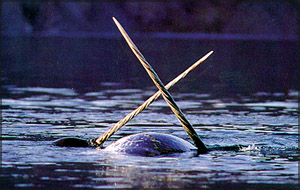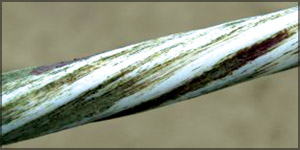|
Narwhals
Unicorns of the sea
Last
week we featured two animals who had bizarre teeth which resembled
antlers and tusks. Today we introduce you to yet another animal whose
most distinctive feature is its overgrown tooth!
|

They live in the Arctic Ocean. |
|

Just friendly ‘tusking’ between two males. |
Unlike the babirusa and warthog, both of whom are land animals
belonging to the pig family, the narwhal is a marine mammal belonging to
the whale family. If you ever see a narwhal you will definitely think it
belongs in a fairytale or a myth.
Narwhals are fascinating creatures that live in the Arctic Ocean.
They are called the 'Unicorns of the sea' because of their unique
overgrown tooth which resembles the legendary and mythical unicorn's
horn or tusk.
All narwhals have two teeth embedded in the upper jaw when they are
born and after the first year, the left tooth of all male narwhals start
to grow upward, spirally, reaching a length of six to nine feet! The
long spiral tooth could weigh up to 22 pounds.
The tooth which is straight as an arrow emerges from the upper jaw
through the upper lip.
|

The narwhal is unique among whales due to its overgrown tooth. |
|

The spiralling tooth is hollow in the centre. |
Even though the right tooth remains embedded in the jaw in a majority
of the males, there have been instances where both teeth have grown
upward like horns, making some narwhals end up with two tusks instead of
the standard one. In some rare instances, females too are reported to
sport a thin, overgrown tooth, which may not be as long as the males'.
Unlike the tusks of elephants, the narwhal's tusk does not grow back
when broken. But, it can repair itself to some extent. The narwhal horn
or tusk, which is spirally twisted in a counter- clockwise direction, is
said to be hollow in the centre.
It is now believed that what led to the unicorn legends in the olden
days were the sightings of narwhals with their unique horns or tusks. In
fact, the narwhal's horn was constantly confused with the spiral tusk of
the mythical unicorn.
It is said that the Vikings who lived in Mediaeval times claimed that
the 'unicorn horn' had magical powers which could detect and destroy any
poison that an enemy put into one's food. They the Vikings are believed
to have passed off the horns of narwhals as those of the mythical
unicorns. For 300 years or more, they had kept the source of the horns a
secret from the Europeans.
This fascinating tooth, which has inspired much legend and lore, is a
scientific mystery, especially since no one really knows what purpose it
serves. Many theories had been put forward as to why male narwhals have
these huge 'unicorn-horns', but todate none has been widely accepted.
Some of the theories are that the horns are used as weapons, they are
tools to break the pack-ice and may even be a status symbol among males
when it comes to selecting a mate, or used for showmanship and
dominance.
|

Some males have two tusks. |
|

The tooth can grow up to nine feet. |
The need to know more about this unique overgrown tooth of the rare
marine mammal has been so great that a special project called the
'Narwhal tooth project' had been launched by a team comprising marine
scientists, mathematicians, evolutionary biologists, mechanical
engineers, dentists, bone biologists and many more research personnel
from different countries.
The team's findings so far have given a new insight into mammalian
teeth.
The narwhals (Monodon Monoceros), unique in the world of whales, are
rare and are seldom seen further than the 70 degrees North latitude.
They inhabit the frigid (cold) waters of the Arctic Ocean from Canada to
Russia through the Norwegian waters, the Davis Strait and around the
Baffin Bay in the Greenland sea.
Males weigh about 1600 kg (3,500 lbs) and females around 1000 kg
(2200 lbs). They grow to a length of 16 ft. (males without the tusks)
and about 13 ft. (females). Their cylindrical bodies are pale in colour,
a bluish-grey with white blotches or brown speckles.
They have no dorsal fins and ears. They resort to echolocation. Their
heads are round, eyes and mouths are small and snouts, rather blunt.
Their compact body shapes and thick layers of blubber (fat) help these
creatures to retain heat in the icy waters of the Arctic Ocean.
They are quick, active mammals and feed primarily on cod that reside
under ice-enclosed seas, squid, shrimp, and other marine fish. When food
is scarce, they may even include baby seals in their diet. Deep divers,
the narwhals are said to dive to depths of at least 1,500 mts ( 5,00 ft)
and stay down for several minutes.
Narwhals are social animals and live in pods of 5-10 or more.
Sometimes many pods get together. As they are the most vocal of all
whales, communicating with each other by way of clicks, squeaks and
whistles, being in the middle of a pod could be deafening for any human,
say researchers.
The males duel in the summer, crossing tusks in a friendly manner and
this is referred to as 'tusking' by scientists. No one knows why they do
so.
Females give birth to a single brown coloured calf, after a gestation
period of 10-16 months, and nurse the young for about four months.
Even though narwhals are not endangered, they are being hunted,
especially by the Inuits of Greenland, and even Canadians for their
skin, blubber, flesh and other edible body parts.
The blubber is used to produce heat and light. The oil from the
blubber, when burnt, does not smoke and the skin which tastes like
seaweed is said to be high in vitamin C. The flesh is fed to the sled
dogs.
Don't you think the narwhals are unique creatures and we need to
protect them?
Facts and pix:
Internet
****
Fact file
* Revered by many cultures around the world, the narwhal's tooth,
most often mistaken for the mythical unicorn's, was also highly priced
by royalty. Two crossed narwhal teeth adorn the entrance to the
Korninkaku Palace in Japan while in Denmark, multiple teeth comprise the
frame of the Danish throne. The royal sceptre in England is also said to
be made from the rare tusk.
* Queen Elizabeth I is believed to have paid 10,000 British pounds
(the cost of an entire castle) in the 16th century to buy the fabled
unicorn tooth.
* The name narwhal in Old Norse means 'corpse whale' and it is
believed that this was due to the narwhals' manner of swimming; often
with their bellies up and laying motionless for several minutes.
* About one in every 500 males has two tusks.
* Narwhals, one of two species of white whales in the Monodontidae
family (the other being the beluga whale), is also related to the
bottlenose dolphin, harbour porpoises and orcas.
* When migrating, narwhals follow the same path every year.
* A newborn narwhal will be about five feet (1.5 mt) long and weigh
about 175-220 lbs.
* A narwhal may live for about 50 years.
* The estimated narwhal population at present is between 10,000 to
45,000 individuals. Apart from humans who are hunting narwhals (and may
someday drive them to extinction), these unique whales have other
enemies such as orcas who hunt them down.
***
The unique tusk
According to facts unravelled through extensive research on the
unique, unicorn-like tusk of the narwhal, it is about four inches in
diameter at the base, tapering to the width of a human baby's finger at
its tip.
Embedded about 15 inches into the head, the tusk grows upward to a
length of 6-9 feet spirally and is hollow in the centre, like an old
tree trunk. Unlike human teeth, which have a hard outer layer of enamel
to protect the softer inner layer, the narwhal's tooth has a soft outer
layer and hard inner layer. This type of tooth could easily bend without
breaking.
Researchers had also discovered a bundle of nerves in the centre of
the tusk like tooth, running from one end to the other. As nerves are
sensory organs, and elephants' tusks have nerves only at the base (not
the entire length), researchers suggest that the 'nerved-tooth' of the
narwhal may have the ability to sense things in the environment.
It may serve as a temperature, pressure or water quality sensor.
Millions of tiny deep tubules extending to the tusk's surface which have
also been discovered on the tusk, are believed to be connected to the
nervous system. Today, a narwhal's tusk could be sold at 4,500 US
dollars. |
